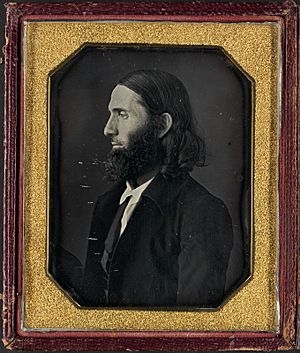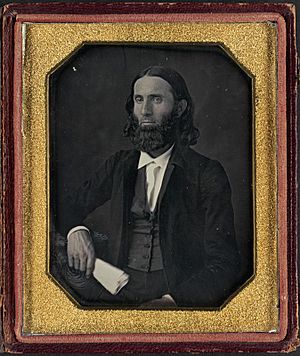Charles Burleigh facts for kids
Charles Calistus Burleigh (born November 3, 1810 – died June 13, 1878) was an American journalist. He was also a strong abolitionist. This means he fought hard to end slavery. He helped people escape slavery through the Underground Railroad. He also spoke out against unfair laws in Connecticut. These laws were called "Black Laws".
Fighting for Freedom
Burleigh became an abolitionist because of a brave teacher. Her name was Prudence Crandall. She tried to open a school for young Black women. People in Canterbury, Connecticut treated her very badly. This was because of her race.
Burleigh wrote an article about this. He wrote it for a newspaper. It was called The Genius of Temperance. Because of this article, he was asked to be an editor. In 1833, he became editor of The Unionist. This newspaper was from Brooklyn, Connecticut.
A Voice for Change
Burleigh was the anti-slavery editor for The Unionist. After 1844, he also edited The Pennsylvania Freeman. He worked as a secretary for the American Anti-Slavery Society. This started in 1836. He also edited their yearly reports.
He traveled all over the Northeast. He visited anti-slavery groups. He helped new groups get started. At a big meeting in 1837, he spoke up. He said that people accused of being runaway slaves should get a fair trial. He also said that owning slaves was wrong. He especially praised the women who helped fight slavery.
Other Important Causes
Burleigh fought for many causes. He wrote a book called Thoughts on the Death Penalty. This book argued against the death penalty. He also supported women's rights. He took part in the 1850 National Women's Rights Convention. This meeting was in Worcester, Massachusetts.
He was known as a great speaker. He had very long hair and a long beard. He promised not to cut them. He said he would wait until slavery ended in the United States.
Personal Life
Charles Calistus Burleigh was born in Plainfield, Connecticut. His parents were Rinaldo Burleigh and Lydia Bradford. He was one of eight children. His brother, Cyrus M. Burleigh, was also an abolitionist.
Charles went to Plainfield Academy. He studied law there. He became a lawyer in Connecticut in 1835. He married Gertrude Kimber in 1842. She was a Quaker from Chester County, Pennsylvania. They had three children. One of their children was the artist Charles Calistus Burleigh, Jr.. Charles Calistus Burleigh died in 1878. He was hit by a train in Florence, Massachusetts.



